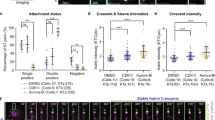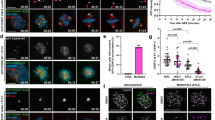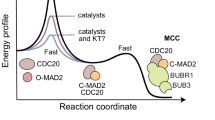Abstract
Faithful genome partition during cell division relies on proper congression of chromosomes to the spindle equator before sister chromatid segregation. Here we uncover a kinesin-7 motor, kinetochore-associated kinesin 1 (KAK1), that is required for mitotic chromosome congression in Arabidopsis. KAK1 associates dynamically with kinetochores throughout mitosis. Loss of KAK1 results in severe defects in chromosome congression at metaphase, yet segregation errors at anaphase are rarely observed. KAK1 specifically interacts with the spindle assembly checkpoint protein BUB3.3 and both proteins show interdependent kinetochore localization. Chromosome misalignment in BUB3.3-depleted plants can be rescued by artificial tethering of KAK1 to kinetochores but not vice versa, demonstrating that KAK1 acts downstream of BUB3.3 to orchestrate microtubule-based chromosome transport at kinetochores. Moreover, we show that KAK1’s motor activity is essential for driving chromosome congression to the metaphase plate. Thus, our findings reveal that plants have repurposed BUB3.3 to interface with a specialized kinesin adapted to integrate proper chromosome congression and checkpoint control through a distinct kinetochore design.
This is a preview of subscription content, access via your institution
Access options
Access Nature and 54 other Nature Portfolio journals
Get Nature+, our best-value online-access subscription
27,99 € / 30 days
cancel any time
Subscribe to this journal
Receive 12 digital issues and online access to articles
118,99 € per year
only 9,92 € per issue
Buy this article
- Purchase on SpringerLink
- Instant access to full article PDF
Prices may be subject to local taxes which are calculated during checkout







Similar content being viewed by others
Data availability
All data of this study are available in the main text or the Supplementary Information. Source data are provided with this paper.
References
Walczak, C. E., Cai, S. & Khodjakov, A. Mechanisms of chromosome behaviour during mitosis. Nat. Rev. Mol. Cell Biol. 11, 91–102 (2010).
Risteski, P., Jagrić, M., Pavin, N. & Tolić, I. M. Biomechanics of chromosome alignment at the spindle midplane. Curr. Biol. 31, R574–R585 (2021).
McAinsh, A. D. & Kops, G. J. P. L. Principles and dynamics of spindle assembly checkpoint signalling. Nat. Rev. Mol. Cell Biol. 24, 543–559 (2023).
Lara-Gonzalez, P., Pines, J. & Desai, A. Spindle assembly checkpoint activation and silencing at kinetochores. Semin. Cell Dev. Biol. 117, 86–98 (2021).
Musacchio, A. The molecular biology of spindle assembly checkpoint signaling dynamics. Curr. Biol. 25, R1002–R1018 (2015).
Schaar, B. T., Chan, G. K., Maddox, P., Salmon, E. D. & Yen, T. J. CENP-E function at kinetochores is essential for chromosome alignment. J. Cell Biol. 139, 1373–1382 (1997).
Craske, B. & Welburn, J. P. I. Leaving no one behind: how CENP-E facilitates chromosome alignment. Essays Biochem. 64, 313–324 (2020).
Wood, K. W., Sakowicz, R., Goldstein, L. S. & Cleveland, D. W. CENP-E is a plus end-directed kinetochore motor required for metaphase chromosome alignment. Cell 91, 357–366 (1997).
Chan, G. K., Schaar, B. T. & Yen, T. J. Characterization of the kinetochore binding ___domain of CENP-E reveals interactions with the kinetochore proteins CENP-F and hBUBR1. J. Cell Biol. 143, 49–63 (1998).
Legal, T. et al. The C-terminal helix of BubR1 is essential for CENP-E-dependent chromosome alignment. J. Cell Sci. 133, jcs246025 (2020).
Guo, Y., Kim, C., Ahmad, S., Zhang, J. & Mao, Y. CENP-E–dependent BubR1 autophosphorylation enhances chromosome alignment and the mitotic checkpoint. J. Cell Biol. 198, 205–217 (2012).
Lampson, M. A. & Kapoor, T. M. The human mitotic checkpoint protein BubR1 regulates chromosome–spindle attachments. Nat. Cell Biol. 7, 93–98 (2005).
Iemura, K. & Tanaka, K. Chromokinesin Kid and kinetochore kinesin CENP-E differentially support chromosome congression without end-on attachment to microtubules. Nat. Commun. 6, 6447 (2015).
Gudimchuk, N. et al. Kinetochore kinesin CENP-E is a processive bi-directional tracker of dynamic microtubule tips. Nat. Cell Biol. 15, 1079–1088 (2013).
Shrestha, R. L. & Draviam, V. M. Lateral to end-on conversion of chromosome–microtubule attachment requires kinesins CENP-E and MCAK. Curr. Biol. 23, 1514–1526 (2013).
Mao, Y., Abrieu, A. & Cleveland, D. W. Activating and silencing the mitotic checkpoint through CENP-E-dependent activation/inactivation of BubR1. Cell 114, 87–98 (2003).
Yu, K.-W., Zhong, N., Xiao, Y. & She, Z.-Y. Mechanisms of kinesin-7 CENP-E in kinetochore–microtubule capture and chromosome alignment during cell division. Biol. Cell 111, 143–160 (2019).
Lee, Y.-R. J., Qiu, W. & Liu, B. Kinesin motors in plants: from subcellular dynamics to motility regulation. Curr. Opin. Plant Biol. 28, 120–126 (2015).
Nebenführ, A. & Dixit, R. Kinesins and myosins: molecular motors that coordinate cellular functions in plants. Annu. Rev. Plant Biol. 69, 329–361 (2018).
Miki, T., Naito, H., Nishina, M. & Goshima, G. Endogenous localizome identifies 43 mitotic kinesins in a plant cell. Proc. Natl Acad. Sci. USA 111, E1053–E1061 (2014).
Deng, X. et al. The Arabidopsis BUB1/MAD3 family protein BMF3 requires BUB3.3 to recruit CDC20 to kinetochores in spindle assembly checkpoint signaling. Proc. Natl Acad. Sci. USA 121, e2322677121 (2024).
van Leene, J. et al. Targeted interactomics reveals a complex core cell cycle machinery in Arabidopsis thaliana. Mol. Syst. Biol. 6, 397 (2010).
Shen, Z., Collatos, A. R., Bibeau, J. P., Furt, F. & Vidali, L. Phylogenetic analysis of the Kinesin superfamily from Physcomitrella. Front. Plant Sci. 3, 230 (2012).
Komaki, S. & Schnittger, A. The spindle assembly checkpoint in Arabidopsis is rapidly shut off during severe stress. Dev. Cell 43, 172–185 (2017).
Lampou, K., Böwer, F., Komaki, S., Köhler, M. & Schnittger, A. A cytological and functional framework of the meiotic spindle assembly checkpoint in Arabidopsis thaliana. Preprint at bioRxiv https://doi.org/10.1101/2023.05.26.542430 (2023).
Brown, K. D., Wood, K. W. & Cleveland, D. W. The kinesin-like protein CENP-E is kinetochore-associated throughout poleward chromosome segregation during anaphase-A. J. Cell Sci. 109, 961–969 (1996).
Howell, B. J. et al. Cytoplasmic dynein/dynactin drives kinetochore protein transport to the spindle poles and has a role in mitotic spindle checkpoint inactivation. J. Cell Biol. 155, 1159–1172 (2001).
Johnson, V. L., Scott, M. I. F., Holt, S. V., Hussein, D. & Taylor, S. S. Bub1 is required for kinetochore localization of BubR1, Cenp-E, Cenp-F and Mad2, and chromosome congression. J. Cell Sci. 117, 1577–1589 (2004).
Akera, T., Goto, Y., Sato, M., Yamamoto, M. & Watanabe, Y. Mad1 promotes chromosome congression by anchoring a kinesin motor to the kinetochore. Nat. Cell Biol. 17, 1124–1133 (2015).
Mao, Y., Desai, A. & Cleveland, D. W. Microtubule capture by CENP-E silences BubR1-dependent mitotic checkpoint signaling. J. Cell Biol. 170, 873–880 (2005).
Weaver, B. A. A. et al. Centromere-associated protein-E is essential for the mammalian mitotic checkpoint to prevent aneuploidy due to single chromosome loss. J. Cell Biol. 162, 551–563 (2003).
Putkey, F. R. et al. Unstable kinetochore–microtubule capture and chromosomal instability following deletion of CENP-E. Dev. Cell 3, 351–365 (2002).
Kozgunova, E., Nishina, M. & Goshima, G. Kinetochore protein depletion underlies cytokinesis failure and somatic polyploidization in the moss Physcomitrella patens. Elife 8, e43652 (2019).
Tromer, E. C., van Hooff, J. J. E., Kops, G. J. P. L. & Snel, B. Mosaic origin of the eukaryotic kinetochore. Proc. Natl Acad. Sci. USA 116, 12873–12882 (2019).
Liu, B. & Lee, Y.-R. J. Spindle assembly and mitosis in plants. Annu. Rev. Plant Biol. 73, 227–254 (2022).
Komaki, S. & Schnittger, A. The spindle checkpoint in plants–a green variation over a conserved theme? Curr. Opin. Plant Biol. 34, 84–91 (2016).
Su, H. et al. Knl1 participates in spindle assembly checkpoint signaling in maize. Proc. Natl Acad. Sci. USA 118, e2022357118 (2021).
Deng, X. et al. A coadapted KNL1 and spindle assembly checkpoint axis orchestrates precise mitosis in Arabidopsis. Proc. Natl Acad. Sci. USA 121, e2316583121 (2024).
Sharp, D. J., Rogers, G. C. & Scholey, J. M. Cytoplasmic dynein is required for poleward chromosome movement during mitosis in Drosophila embryos. Nat. Cell Biol. 2, 922–930 (2000).
Yang, Z., Tulu, U. S., Wadsworth, P. & Rieder, C. L. Kinetochore dynein is required for chromosome motion and congression independent of the spindle checkpoint. Curr. Biol. 17, 973–980 (2007).
Varma, D., Monzo, P., Stehman, S. A. & Vallee, R. B. Direct role of dynein motor in stable kinetochore–microtubule attachment, orientation, and alignment. J. Cell Biol. 182, 1045–1054 (2008).
Wandke, C. et al. Human chromokinesins promote chromosome congression and spindle microtubule dynamics during mitosis. J. Cell Biol. 198, 847–863 (2012).
Stumpff, J., Wagenbach, M., Franck, A., Asbury, C. L. & Wordeman, L. Kif18A and chromokinesins confine centromere movements via microtubule growth suppression and spatial control of kinetochore tension. Dev. Cell 22, 1017–1029 (2012).
Vanstraelen, M., Inzé, D. & Geelen, D. Mitosis-specific kinesins in Arabidopsis. Trends Plant Sci. 11, 167–175 (2006).
Kim, Y., Holland, A. J., Lan, W. & Cleveland, D. W. Aurora kinases and protein phosphatase 1 mediate chromosome congression through regulation of CENP-E. Cell 142, 444–455 (2010).
Eibes, S. et al. CENP-E activation by Aurora A and B controls kinetochore fibrous corona disassembly. Nat. Commun. 14, 5317 (2023).
Deng, X., Xiao, Y., Tang, X., Liu, B. & Lin, H. Arabidopsis α-Aurora kinase plays a role in cytokinesis through regulating MAP65-3 association with microtubules at phragmoplast midzone. Nat. Commun. 15, 3779 (2024).
Acknowledgements
We thank A. Schnittger and S. Komaki for sharing the SAC plasmids and T. Nakagawa for providing pGWB vectors. This study was supported by the National Natural Science Foundation of China (grant no. 32270354), Natural Science Foundation of Sichuan Province (grant no. 2022NSFSC1651) and Sichuan Forage Innovation Team Program (grant no. SCCXTD-2024-16).
Author information
Authors and Affiliations
Contributions
X.D. conceived and supervised the project. X.D., X.T., Y.T. and Y.H. performed most of the experiments. X.D., X.T. and Y.T. analysed the data. X.D. wrote the paper. K.C., H.L. and B.L. read and revised the paper. All authors approved the paper submission.
Corresponding author
Ethics declarations
Competing interests
The authors declare no competing interests.
Peer review
Peer review information
Nature Plants thanks Katharina Bürstenbinder, Ravi Maruthachalam and the other, anonymous, reviewer(s) for their contribution to the peer review of this work.
Additional information
Publisher’s note Springer Nature remains neutral with regard to jurisdictional claims in published maps and institutional affiliations.
Extended data
Extended Data Fig. 1 KAK1 belongs to the kinesin-7 group.
The phylogenetic tree shows the evolutionary relationship of the KAK1 protein from the plant species A. thaliana to other members of the kinesin-7 subfamily, including CENP-E from H. sapiens and KIP2 from S. cerevisiae. Amino acid sequences are aligned using the MUSCLE method. The tree is constructed using the neighbor-joining method within MEGA software, with gaps automatically removed using the complete-deletion option. The estimated evolutionary distances are indicated by the numbers above each branch, representing amino acid substitutions per site. The reliability of each branch is shown by the score next to each node, with the highest value being 100.
Extended Data Fig. 2 Defective chromosome congression in the kak1 mutant.
a, Chromosomes congression and segregation in WT and kak1 plants with or without oryzalin treatment. The fluorescent signals are detected by immunofluorescence, with MTs detected by the anti-tubulin antibody shown in green, and DNA detected by DAPI shown in magenta. Scale bars, 5 μm. b, Quantitative assessment of cells exhibiting misaligned chromosomes at metaphase and anaphase.
Extended Data Fig. 3 Pull-down assays of recombinant MBP fusions of KAK1 variants with GST- BUB3.3 immobilized beads.
The additional bands in the KAK1(1-600) sample line likely correspond to degradation products of the KAK1 N-terminal fragment during the co-purification process. The experiment was repeated three times with similar results.
Extended Data Fig. 4 Impact of SAC mutants on chromosome congression.
a-f, Representative immunofluorescence images of mitotic cells from different SAC mutant backgrounds, including bub3.3 (a), mps1 (b), bmf1 (c), bmf2 bmf3 (d), mad1 (e), and mad2 (f). The MTs are visualized in green using an anti-tubulin antibody, and DNA is stained with DAPI (magenta). Scale bars, 5 μm. g-h, Quantitative assessment of cells exhibiting misaligned chromosomes at metaphase (g) and anaphase (h) in different SAC mutant backgrounds.
Extended Data Fig. 5 Loss of KAK1 in mad1 and bub3.3 mutants does not affect plant growth.
Representative image of growth phenotypes of 3-week-old WT, kak1, mad1, kak1 mad1, bub3.3, and kak1 bub3.3 plants. Scale bars, 1 cm.
Extended Data Fig. 6 The kak1 mad1 double mutant exhibits increased sensitivity to oryzalin treatment.
a, Representative images of 10-day-old seedlings of the WT, kak1, mad1, and kak1 mad1 genotypes, grown either with or without 75 nM oryzalin. Scale bars, 1 cm. b, Quantification of root lengths in the seedlings with and without oryzalin treatment. Graph bars represent means ± SD of six seedlings per genotype. The statistical significance (***P < 10-6) was determined by one-way ANOVA followed by Tukey test. The experiment was repeated three times with similar results.
Extended Data Fig. 7 The kak1 mad1 double mutant generates aneuploid daughter cells.
a, Representative immunofluorescence images of WT cells (n = 52) at the end of mitosis, where the forming daughter cells consistently exhibit 10 kinetochore signals, as detected by the anti-CENH3 antibody (green). The MTs (magenta) and DNA (blue) are also visualized. b, Representative immunofluorescence images of kak1 mad1 mutant cells (n = 55) displaying aberrant chromosome segregation patterns. In the double mutant cells, the daughter cell pairs exhibit an unequal distribution of kinetochore signals, with pairs having 9 + 11 or 8 + 12 CENH3 signals. The immunofluorescence images are obtained through confocal-based z-stack projections of cells undergoing cytokinesis, allowing the visualization of all kinetochore signals in the forming daughter cells. Scale bars, 5 μm.
Extended Data Fig. 8 KAK1 is not essential for kinetochore localization of core SAC proteins.
a-b, GFP-MAD1 is detected at kinetochores upon expression in mad1 mutant (a) and kak1 mutant (b) backgrounds in representative cells at prophase (top row) and metaphase (bottom row). c-d, BMF3-GFP is detected at kinetochores upon expression in bmf3 mutant (c) and kak1 (d) mutant backgrounds. The fluorescent signals are detected by immunofluorescence and merged images have GFP-tagged proteins detected by anti-GFP shown in green, MTs detected by anti-tubulin shown in magenta, and DNA detected by DAPI shown in blue. Micrographs are representative of more than 60 cells from three independent lines with similar results. Scale bars, 5 μm.
Supplementary information
Supplementary Information
Supplementary Figs. 1–6 and Table 1.
Supplementary Video 1
Live-cell imaging of WT cells expressing GFP–TUB6 and histone H1.2–RFP. Images were acquired every 20 s. Scale bars, 5 μm.
Supplementary Video 2
Live-cell imaging of kak1 mutant cells expressing GFP–TUB6 and histone H1.2–RFP. Images were acquired every 20 s. Scale bars, 5 μm.
Supplementary Video 3
Live-cell imaging of mad1 mutant cells expressing GFP–TUB6 and histone H1.2–RFP. Images were acquired every 20 s. Scale bars, 5 μm.
Supplementary Video 4
Live-cell imaging of kak1 mad1 double-mutant cells expressing GFP–TUB6 and histone H1.2–RFP. Images were acquired every 20 s. Scale bars, 5 μm.
Supplementary Video 5
Live-cell imaging of bub3.3 mutant cells expressing GFP–TUB6 and histone H1.2–RFP. Images were acquired every 20 s. Scale bars, 5 μm.
Supplementary Video 6
Live-cell imaging of kak1 bub3.3 double mutant cells expressing GFP–TUB6 and histone H1.2–RFP. Images were acquired every 20 s. Scale bars, 5 μm.
Supplementary Data 1
Co-immunoprecipitation and mass spectrometry results for GFP–BUB3.3 as a bait.
Supplementary Data 2
Co-immunoprecipitation and mass spectrometry results for KAK1–GFP as a bait.
Source data
Source Data Fig. 1
Statistical source data.
Source Data Fig. 6
Statistical source data.
Source Data Fig. 7
Statistical source data.
Source Data Extended Data Fig. 3
Unprocessed western blots.
Source Data Extended Data Fig. 6
Statistical source data.
Rights and permissions
Springer Nature or its licensor (e.g. a society or other partner) holds exclusive rights to this article under a publishing agreement with the author(s) or other rightsholder(s); author self-archiving of the accepted manuscript version of this article is solely governed by the terms of such publishing agreement and applicable law.
About this article
Cite this article
Tang, X., He, Y., Tang, Y. et al. A kinetochore-associated kinesin-7 motor cooperates with BUB3.3 to regulate mitotic chromosome congression in Arabidopsis thaliana. Nat. Plants 10, 1724–1736 (2024). https://doi.org/10.1038/s41477-024-01824-7
Received:
Accepted:
Published:
Issue Date:
DOI: https://doi.org/10.1038/s41477-024-01824-7



